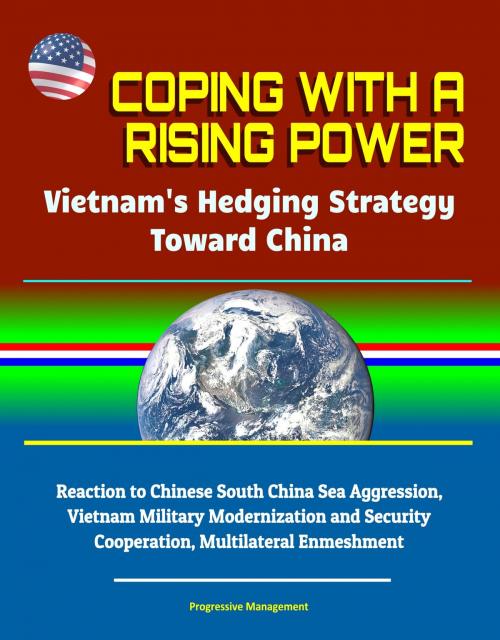Coping With a Rising Power: Vietnam's Hedging Strategy Toward China - Reaction to Chinese South China Sea Aggression, Vietnam Military Modernization and Security Cooperation, Multilateral Enmeshment
Nonfiction, History, Asian, Southeast Asia, China| Author: | Progressive Management | ISBN: | 9780463138588 |
| Publisher: | Progressive Management | Publication: | June 10, 2018 |
| Imprint: | Smashwords Edition | Language: | English |
| Author: | Progressive Management |
| ISBN: | 9780463138588 |
| Publisher: | Progressive Management |
| Publication: | June 10, 2018 |
| Imprint: | Smashwords Edition |
| Language: | English |
This report has been professionally converted for accurate flowing-text e-book format reproduction.
The competition for power and influence between China and the United States in Southeast Asia has presented strategic uncertainties in the region. Vietnam, like the rest of Southeast Asia, has adopted a hedging strategy to minimize security and political risks, and maximize the diplomatic benefits of flexibility. In recent years, however, China's increasing aggression in the South China Sea may have put pressure on Vietnam to balance against China. By using a hedging spectrum between balancing and bandwagoning, this thesis seeks to understand Vietnam's hedging behavior in response to China's aggression and the possible reasons for that degree of change. It examines how Vietnam continues to pursue contradictory hedging behaviors to address Hanoi' s low-intensity balancing policies toward China while providing a closer engagement and solidarity with Beijing. This thesis found that Vietnam's hedging behavior has shifted toward the balancing end of the hedging spectrum. In addition, Vietnam continues to put greater emphasis on indirect-balancing and dominance-denial policies, which also signify a degree of power rejection vis-a-vis China.
This thesis offers two distinct explanations for Vietnam's current trend toward the balancing behavior. First, through military modernization and security cooperation, Vietnam' s indirect balancing component has been strengthened, and second, Vietnam's recent bilateral and multilateral enmeshment strategies have led it to a greater commitment to dominance denial, cultivating a balance of power and binding processes through institutionalist mechanisms.
I. INTRODUCTION * A. MAJOR RESEARCH QUESTION * B. SIGNIFICANCE OF THE RESEARCH QUESTION * C. LITERATURE REVIEW * 1. Balance, Bandwagon, or Hedge? * 2. Vietnam's Hedging Policy since 1990s * 3. Vietnam's Hedging Policy since 2010 * D. POTENTIAL EXPLANATION AND HYPOTHESIS * E. RESEARCH DESIGN * F. THESIS OVERVIEW * II. VIETNAM'S MILITARY MODERNIZATION * A. MILITARY MODERNIZATION IN VIETNAM * 1. Weapons Procurement * 2. Domestic Defense Industry * B. CAUSES OF MILITARY MODERNIZATION * 1. China as a Factor * 2. Economic Growth as a Factor * C. ANALYSIS * III. VIETNAM'S ENMESHMENT STRATEGY * A. VIETNAM'S BILATERAL DIPLOMACY * 1. Japan * 2. India * 3. China * 4. The United States * B. VIETNAM'S MULTILATERAL DIPLOMACY * 1. Transforming and Constraining China through Enmeshment * 2. Limitations in Enmeshing China through ASEAN * C. ANALYSIS * IV. CONCLUSION * A. ADDRESSING HYPOTHESIS AND RESEARCH PURPOSE * B. ASSESSING VIETNAM'S INCLINATION
This report has been professionally converted for accurate flowing-text e-book format reproduction.
The competition for power and influence between China and the United States in Southeast Asia has presented strategic uncertainties in the region. Vietnam, like the rest of Southeast Asia, has adopted a hedging strategy to minimize security and political risks, and maximize the diplomatic benefits of flexibility. In recent years, however, China's increasing aggression in the South China Sea may have put pressure on Vietnam to balance against China. By using a hedging spectrum between balancing and bandwagoning, this thesis seeks to understand Vietnam's hedging behavior in response to China's aggression and the possible reasons for that degree of change. It examines how Vietnam continues to pursue contradictory hedging behaviors to address Hanoi' s low-intensity balancing policies toward China while providing a closer engagement and solidarity with Beijing. This thesis found that Vietnam's hedging behavior has shifted toward the balancing end of the hedging spectrum. In addition, Vietnam continues to put greater emphasis on indirect-balancing and dominance-denial policies, which also signify a degree of power rejection vis-a-vis China.
This thesis offers two distinct explanations for Vietnam's current trend toward the balancing behavior. First, through military modernization and security cooperation, Vietnam' s indirect balancing component has been strengthened, and second, Vietnam's recent bilateral and multilateral enmeshment strategies have led it to a greater commitment to dominance denial, cultivating a balance of power and binding processes through institutionalist mechanisms.
I. INTRODUCTION * A. MAJOR RESEARCH QUESTION * B. SIGNIFICANCE OF THE RESEARCH QUESTION * C. LITERATURE REVIEW * 1. Balance, Bandwagon, or Hedge? * 2. Vietnam's Hedging Policy since 1990s * 3. Vietnam's Hedging Policy since 2010 * D. POTENTIAL EXPLANATION AND HYPOTHESIS * E. RESEARCH DESIGN * F. THESIS OVERVIEW * II. VIETNAM'S MILITARY MODERNIZATION * A. MILITARY MODERNIZATION IN VIETNAM * 1. Weapons Procurement * 2. Domestic Defense Industry * B. CAUSES OF MILITARY MODERNIZATION * 1. China as a Factor * 2. Economic Growth as a Factor * C. ANALYSIS * III. VIETNAM'S ENMESHMENT STRATEGY * A. VIETNAM'S BILATERAL DIPLOMACY * 1. Japan * 2. India * 3. China * 4. The United States * B. VIETNAM'S MULTILATERAL DIPLOMACY * 1. Transforming and Constraining China through Enmeshment * 2. Limitations in Enmeshing China through ASEAN * C. ANALYSIS * IV. CONCLUSION * A. ADDRESSING HYPOTHESIS AND RESEARCH PURPOSE * B. ASSESSING VIETNAM'S INCLINATION















